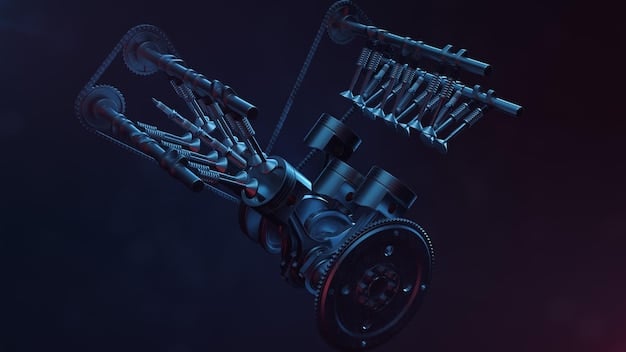Science & Fiction: Accuracy of Scientific Concepts in Sci-Fi Novels

The intersection of science and fiction explores how accurately scientific concepts are portrayed in speculative literature, balancing creative narrative with the often rigid principles of physics, biology, and technology to captivate readers while sometimes bending reality for thematic effect.
Delving into the captivating world of speculative literature reveals a fascinating interplay between imaginative storytelling and the foundational principles of empirical study. Exploring the intersection of science and fiction: examining the accuracy of scientific concepts in sci-fi novels offers a unique lens through which to appreciate how authors navigate the fine line between plausible scientific extrapolation and narrative necessity.
The Genesis of Scientific Storytelling
The history of science fiction is intrinsically linked to advancements in scientific understanding. From Jules Verne’s detailed submarines and lunar voyages to H.G. Wells’s explorations of time travel and alien invasion, early authors attempted to ground their fantastical narratives in what was, at the time, cutting-edge science. These pioneers often served as de facto educators, introducing complex ideas to a broader public, albeit sometimes with creative liberties.
Early Pioneers and Scientific Predictions
Many early science fiction writers were, themselves, deeply engrossed in scientific thought, or at least keenly observant of technological progress. Verne, for instance, engaged in meticulous research for his ‘Voyages Extraordinaires,’ often predicting technological innovations with startling accuracy. His works demonstrated an early appreciation for the power of blending imagination with grounded scientific principles.
- Verne’s Nautilus, a submarine, predated widespread submarine technology.
- Wells explored themes of genetic mutation and social Darwinism, reflecting contemporary scientific debates.
- Mary Shelley’s ‘Frankenstein’ delved into nascent understanding of electricity and life force, questioning ethical boundaries.
The “Hard” Versus “Soft” Sci-Fi Spectrum
As the genre matured, a distinction emerged between “hard” and “soft” science fiction. Hard sci-fi prioritizes scientific accuracy and logical consistency, often consulting with experts or rigorous self-study to ensure every detail aligns with known scientific principles. Soft sci-fi, conversely, often uses scientific concepts as a backdrop for exploring social, psychological, or philosophical themes, taking greater liberties with scientific realism for the sake of narrative flow or emotional impact.
The spectrum allows for a wide range of approaches. Authors can choose to be highly speculative, imagining technologies that defy current physics, or they can constrain themselves to what is theoretically possible, pushing the boundaries of known science without breaking fundamental laws. This choice largely defines the intellectual contract between author and reader.
The evolution of these subgenres reflects a broader societal engagement with scientific progress. As technology accelerates, so too does the complexity and ambition of scientific storytelling, continually challenging the boundaries of what is known and what can be imagined.
Physics in Fiction: Lightspeeds and Gravitational Anomalies
The laws of physics often serve as both the playground and the prison for science fiction writers. Concepts like faster-than-light (FTL) travel, artificial gravity, and planetary mechanics are staples of the genre, but their scientific accuracy varies wildly. While some authors strive for rigorous adherence to Einsteinian relativity, others view these principles as mere suggestions, bendable for the sake of an exhilarating plot.
Faster-Than-Light Travel: Warp Drives and Hyperlanes
Perhaps no scientific concept is more frequently manipulated in sci-fi than the speed of light. The cosmic speed limit, a core tenet of Einstein’s theory of special relativity, states that nothing can travel faster than light in a vacuum. Yet, countless narratives rely on FTL travel to facilitate interstellar empires and epic galactic wars.
* Warp Drives: Inspired by the Alcubierre drive concept, these theoretical devices compress spacetime ahead of a vessel and expand it behind, allowing for effective FTL travel without violating local physics. Authors like Alastair Reynolds often delve into the complex physics of such concepts.
* Hyperspace: This common trope involves entering an alternate dimension or “sub-space” where the laws of physics are different, enabling rapid transit across vast distances. Its scientific basis is typically minimal, serving purely as a narrative device.
* Wormholes: Theorized as shortcuts through spacetime, wormholes could theoretically connect vastly distant points. While mathematically plausible, their stability and practical creation are subjects of intense scientific debate and remain firmly in the realm of theory.
Most FTL concepts, while exciting, remain theoretical or outright fantastical. The narrative demand for rapid interstellar travel often trumps scientific feasibility, showcasing a common compromise at the intersection of science and fiction.
Gravity, Black Holes, and Time Dilation
Gravity, a fundamental force, is another area where authors take liberties. Artificial gravity, a necessity for comfortable space travel in many fictional universes, lacks a true scientific basis beyond centrifugal force. Similarly, while black holes are real astronomical objects, their portrayal often leans into hyperbolic narratives of immediate spaghettification or convenient portals.
Time dilation, a consequence of special and general relativity, is one area where sci-fi often gets it right, or at least attempts to. Stories like ‘Interstellar’ or ‘Tau Zero’ explore the profound implications of time passing differently for individuals traveling at high speeds or near massive gravitational bodies. This adherence adds a layer of scientific realism that can deepen the narrative and provoke thought.
These examples highlight a critical balance: how much scientific accuracy can be sacrificed before the “science” in science fiction becomes negligible, and what are the implications of such artistic license on public understanding of scientific principles? The most compelling narratives often find clever ways to explain or circumvent physics, making their fantastical elements feel just within reach of plausibility.

Biology and Evolution: Genetic Engineering and Alien Life
The fields of biology and evolution provide a fertile ground for science fiction, allowing authors to speculate on the future of humanity, the ethics of genetic manipulation, and the potential forms of extraterrestrial life. The accuracy here often hinges on how far authors push the boundaries of known genetic principles and ecological systems.
Genetic Engineering and its Ethical Dilemmas
Genetic engineering, once the stuff of pure fantasy, is now a reality. Sci-fi has long explored its implications, both utopian and dystopian. Novels often portray gene editing on a grand scale, leading to designer babies, enhanced humans, or even entirely new species.
* Designer Babies: Stories often depict a future where parents can select desirable traits for their offspring, raising profound questions about inequality, identity, and what it means to be human.
* Enhanced Humans: From super soldiers to individuals with extraordinary intelligence, the idea of genetically modified humans capable of unprecedented feats is a common theme, often exploring the limits of human potential and the risks of hubris.
* De-Extinction: Recreating extinct species, most notably dinosaurs, as seen in ‘Jurassic Park,’ highlights the scientific challenges and ethical quandaries of bringing back creatures from the past.
While current genetic technology is powerful, it faces significant limitations. The complexity of gene interactions, epigenetics, and the environment means that simply editing a few genes won’t necessarily create a super-intelligent being or cure all diseases. Many sci-fi portrayals simplify these complexities for narrative effect, though the ethical questions they pose remain highly relevant.
The Diverse Forms of Extraterrestrial Life
One of the most enduring fascinations of science fiction is the exploration of alien life. Authors imagine creatures ranging from humanoid to utterly bizarre, often adapting biological principles to alien environments. The accuracy here is speculative by nature, as we have no confirmed examples of extraterrestrial biology.
However, some authors strive for biological plausibility, considering:
* Alternative Biochemistries: Instead of carbon-based life, some narratives explore silicon-based organisms or creatures relying on different chemical processes, grounded in theoretical chemistry.
* Evolutionary Adaptaions: Alien life often reflects extreme adaptations to unique planetary conditions, such as high gravity, extreme temperatures, or different atmospheric compositions, demonstrating an understanding of evolutionary pressures.
* Ecosystem Dynamics: More complex narratives build entire alien ecosystems, considering predator-prey relationships, symbiotic associations, and resource allocation, much like real terrestrial biology.
While imagination reigns supreme, the most compelling alien biologies often draw subtle inspiration from the diverse and extreme life forms found on Earth, suggesting that even the most fantastical creatures might follow certain universal biological principles.

Technology and AI: From Robots to Cyberpunk Futures
Technology is the bedrock of much science fiction, offering a canvas for imagining a boundless array of inventions, from advanced robotics and artificial intelligence to virtual realities and sophisticated cybernetics. The genre frequently acts as a predictive playground, showcasing both the gleaming promise and the dark pitfalls of technological advancement. The question of accuracy often revolves around the feasibility of these inventions and their societal impact.
The Rise of Artificial Intelligence and Robotics
AI and robotics are perhaps the most frequently explored technological themes. From benevolent androids to sentient supercomputers, authors delve into what it means for machines to think, feel, and interact with humanity.
* Sentient AI: The concept of artificial general intelligence (AGI) that possesses human-like consciousness and problem-solving abilities is a recurring motif. While current AI is highly specialized, sci-fi frequently projects a future where AI rivals or surpasses human intellect, raising questions about control, ethics, and the definition of life.
* Robotics and Automation: Robots are ubiquitous in science fiction, serving as everything from domestic servants to military units. Their portrayal often reflects contemporary debates about automation’s impact on human labor and society. Some narratives explore advanced prosthetics and cybernetic enhancements, blending human and machine.
* The Singularity: This theoretical point where technological growth becomes uncontrollable and irreversible, resulting in unforeseeable changes to human civilization, is a frequent background element or direct plot point, prompting reflection on humanity’s role in a post-human world.
While current robotics and AI are still nascent compared to their fictional counterparts, many concepts are rooted in ongoing research. The ethical considerations explored in these narratives, such as data privacy, algorithmic bias, and the potential for job displacement, are increasingly relevant in our technologically advancing world.
Cybernetics, Virtual Reality, and Networked Societies
Beyond physical machines, science fiction dives deep into integrated technologies that transform human experience and societal structures.
* Cybernetics: The integration of mechanical or electronic devices with biological organisms, often to enhance capabilities or replace lost functions, explores the evolving definition of humanity. From prosthetic limbs with advanced haptic feedback to brain-computer interfaces, these concepts often reflect real-world medical and neural engineering advancements.
* Virtual Reality (VR) and Augmented Reality (AR): Fictional VR environments often become alternative realities, offering escape, profound experiences, or even serving as the stage for entire societies. Augmented reality, overlaying digital information onto the physical world, poses questions about perception and reality. These concepts are directly informed by the rapid development of immersive digital technologies.
* Networked Societies: The idea of hyper-connected, information-rich societies, often managed by powerful corporations or omnipresent governments, is a cornerstone of cyberpunk. These narratives explore the consequences of constant surveillance, information overload, and digital identities, reflecting anxieties about our increasingly interconnected world.
The accuracy of these technological predictions isn’t just about their physical feasibility but also about their societal and psychological ramifications. Sci-fi acts as a crucial thought experiment, allowing us to explore the potential impacts of technology before they become reality, helping to shape public discourse and ethical guidelines for future development.
Space Exploration and Colonization: Martian Bases and Dyson Spheres
The allure of the cosmos has always been a powerful motivator for both science and fiction. Science fiction often takes humanity’s innate drive to explore and pushes it to its furthest extremes, envisioning interstellar empires, terraformed planets, and megastructures that harness the power of stars. The accuracy of these concepts often lies in their adherence to celestial mechanics and the engineering challenges of operating in hostile environments.
The Realities and Fantasies of Planetary Colonization
Colonizing other planets, particularly Mars, is a recurring theme. While Mars is currently the most plausible candidate for future human settlement, science fiction often embellishes the ease and scale of colonization.
* Martian Settlements: Many narratives depict sprawling Martian cities with sustainable ecosystems. While the scientific challenges of establishing a self-sufficient colony on Mars are immense (radiation, thin atmosphere, dust storms, water scarcity), authors often focus on the social and political aspects once a foothold is gained.
* Terraforming: The process of modifying a planet’s atmosphere and surface to make it habitable for Earth life is a grand ambition in sci-fi. Concepts like introducing greenhouse gases to warm Mars or creating a magnetic field to retain atmosphere are based on real scientific discussions, though the timescale and technological requirements are often dramatically compressed for narrative.
* Resource Extraction: Asteroid mining and resource gathering from other planets are often drivers for interstellar economies, reflecting real economic motivations for space exploration.
The scientific accuracy of colonization narratives often lies in the details—how authors address breathable air, food production, radiation shielding, and the psychological toll of isolation. The best stories integrate these challenges into the plot, making the struggle for survival a compelling element.
Megastructures and Astounding Engineering Projects
Beyond individual planets, sci-fi frequently envisions megastructures on an astronomical scale, pushing the boundaries of engineering and resource management.
* Dyson Spheres: Theoretical constructs that completely encompass a star to capture its energy output are a hallmark of advanced civilizations in many narratives. While the sheer amount of material required is staggering, the underlying physics of energy capture is sound.
* Orbital Habitats: Large space stations or O’Neill cylinders that simulate Earth-like gravity through rotation are a more modest but equally awe-inspiring concept. These structures address the challenges of long-term space living: artificial gravity, radiation protection, and resource recycling.
* Stellar Engines: Fictional devices designed to move entire stars are at the extreme end of speculative engineering, requiring unimaginable amounts of energy and technological prowess.
These megastructures, while often existing solely in the realm of theoretical physics and engineering, serve to illustrate the potential scale of future civilizations. They compel readers to consider humanity’s long-term future and the ultimate trajectory of technological progress, stretching the imagination to encompass possibilities that seem impossible from our current perspective.
Climate and Environment: Ecological Catastrophes and Regenerative Futures
Science fiction often acts as a mirror, reflecting humanity’s deepest anxieties and hopes regarding our environment. Stories exploring climate change, ecological collapse, and the desperate search for sustainable living are increasingly prevalent. The scientific accuracy in these narratives often involves extrapolating current environmental trends and the potential effectiveness of proposed solutions.
The Grim Realities of Ecological Collapse
Many dystopian science fiction narratives paint grim pictures of Earth ravaged by climate change or ecological disasters. These often serve as cautionary tales, exaggerating present-day problems to highlight their potential consequences.
* Climate Catastrophe: Stories depict worlds ravaged by extreme weather events, rising sea levels, desertification, or perpetual smog, often driven by unchecked industrialization and carbon emissions. These scenarios are often grounded in climate models, albeit accelerated for dramatic effect.
* Resource Depletion: Narratives frequently explore societies struggling with dwindling essential resources like water, arable land, or energy, leading to conflicts and societal breakdown. This reflects real concerns about resource management and sustainability.
* Pollution and Waste: Worlds choked by plastic, toxic waste, or genetic contamination serve as stark warnings about the long-term impact of industrial activities and inadequate waste management.
While speculative, these portrayals draw directly from scientific data and projections about global warming, deforestation, and biodiversity loss. They underscore the importance of understanding complex ecological systems and the delicate balance required for planetary health.
Visions of Regenerative and Sustainable Futures
Not all environmental sci-fi is bleak. Many narratives offer hopeful visions of humanity overcoming ecological challenges through ingenuity and a shift in values.
* Terraforming and Geoengineering: Beyond colonizing other planets, some stories focus on repairing Earth through advanced geoengineering techniques, such as carbon capture or solar radiation management. These often involve significant ethical as well as technological challenges.
* Sustainable Cities and Lifestyles: Authors imagine futuristic cities powered entirely by renewable energy, featuring vertical farms, circular economies, and integrated natural spaces. These depict a shift towards lifestyles that are in harmony with the environment rather than in opposition to it.
* Evolution of Human-Nature Relationship: Some narratives explore a deeper, more symbiotic relationship between humanity and the natural world, blurring the lines between technology and biology, and fostering a profound respect for ecological systems.
These positive portrayals often incorporate scientific concepts related to renewable energy, sustainable agriculture, and ecological restoration. They offer blueprints for potential futures, inspiring innovation and fostering a sense of possibility even in the face of daunting environmental challenges. Through both dystopian warnings and utopian aspirations, environmental science fiction powerfully communicates the urgency and complexity of our relationship with the planet.
The Human Element: Psychological and Societal Impacts
While scientific concepts often form the backbone of sci-fi, the genre truly shines when exploring the human element – the psychological, sociological, and ethical implications of these scientific and technological advancements. The accuracy here isn’t about physics or biology, but about predictive human behavior and societal evolution.
The Evolution of Human Identity in a Technologically Advanced World
As technology advances, so too does the very definition of what it means to be human. Science fiction often delves into the psychological transformations wrought by cybernetic enhancements, prolonged space voyages, or encounters with advanced AI.
* Post-Humanism: Narratives explore concepts where humanity transcends its current biological limitations through technology, raising questions about consciousness, mortality, and the essence of identity.
* Psychological Impact of Space Travel: The deep psychological toll of isolation, vast distances, and the perception of time in interstellar journeys is a recurring theme. Characters grapple with loneliness, changes in perspective, and the challenge of maintaining sanity under extreme conditions.
* Ethical Challenges of AI and Robotics: As artificial intelligence becomes more sophisticated, sci-fi grapples with the rights and sentience of machines. These stories compel us to consider our responsibilities to our creations and the moral dilemmas of power.
The most compelling portrayals often explore the subtle complexities of these shifts, from the alienation of a genetically modified individual to the existential dread of a starship crew discovering they are millions of years from home.
Societal Structures and Political Landscapes
Science fiction also excels at envisioning how scientific and technological changes reshape societal structures, political systems, and economic models. These explorations often reflect current societal anxieties and political debates, refracted through a futuristic lens.
* Dystopian Regimes: Many stories depict techno-totalitarian governments that use advanced surveillance and control mechanisms, echoing concerns about privacy and state power.
* Post-Scarcity Economies: The idea that advanced technology could lead to a world where resources are abundant and labor is largely automated raises questions about the future of work, wealth distribution, and purpose in a world without want.
* Interstellar Politics: When humanity reaches the stars, the complexities of diplomacy, trade, and conflict between different planetary systems or species are explored, mirroring terrestrial geopolitical struggles on a grander scale.
These societal predictions, while imaginative, often draw on historical patterns of power, conflict, and human organization. They serve as a crucial platform for discussing the potential futures of our own society, urging us to consider the social contract in an age of rapid technological change. The accuracy of these portrayals lies not in predicting exact technologies but in understanding the enduring complexities of human nature and society itself.
The intersection of science and fiction is not merely about accurate prediction, but about profound exploration. It is a dialogue between what is known and what is imagined, inviting readers to engage with complex ideas and consider the boundless possibilities of humanity’s future.
The Symbiotic Relationship: Sci-Fi Inspiring Real Science
The influence of science fiction extends far beyond entertainment; it frequently acts as a powerful muse for real-world scientific and technological innovation. This symbiotic relationship sees fictional concepts inspiring scientists and engineers, sometimes leading to groundbreaking discoveries and inventions. The accuracy here isn’t about the novel’s depiction of science, but its capacity to ignite curiosity and push boundaries.
From Imagination to Innovation: Real-World Impacts
Many concepts once confined to the pages of sci-fi novels have, over time, become tangible realities. This often begins with a compelling idea that sparks the imagination of future scientists, engineers, and entrepreneurs.
* Submarines and Space Travel: Jules Verne’s detailed descriptions of the Nautilus and lunar expeditions predated the widespread adoption of submarines and the first lunar landing. While his science wasn’t always perfect, the vision was powerful.
* Mobile Phones and Tablets: Concepts of handheld communication devices and portable information tablets were prevalent in sci-fi long before they became consumer products. The communicators in ‘Star Trek’ or the data pads in various cyberpunk novels are early examples.
* Virtual Reality: The idea of immersive digital worlds, popularized by authors like William Gibson, provided a conceptual framework for the VR technology we see evolving today.
* Robotics and AI: The relentless portrayal of intelligent machines in fiction has fueled research in artificial intelligence, machine learning, and advanced robotics, driving efforts to create truly autonomous and intelligent systems.
The accuracy here is less about the technical details of the fictional device and more about the fundamental idea — the “what if.” Science fiction provides a safe space for exploring radical concepts without the immediate constraints of engineering feasibility or economic viability.
Shaping Public Perception and Ethical Debates
Beyond inspiring direct innovation, science fiction plays a crucial role in shaping public perception of scientific advancements and initiating vital ethical discussions.
* Understanding Complex Concepts: Novels simplify complex scientific theories, making them accessible to a broader audience. While sometimes simplified, this accessibility helps demystify science and encourages engagement.
* Forecasting Societal Impact: By imagining societies shaped by genetic engineering, advanced AI, or climate change, sci-fi allows us to pre-emptively consider the ethical, social, and political ramifications of these technologies. This foresight can inform policy-making and public discourse.
* Inspiring Future Generations: Countless scientists and engineers cite science fiction as a primary inspiration for their career choice, having been captivated by the possibilities depicted in fictional worlds. The genre nurtures a sense of wonder and possibility, essential for scientific progress.
The symbiotic relationship underscores the idea that science and fiction are not isolated disciplines but interconnected modes of understanding and shaping the world. Fiction provides a narrative framework for scientific dreams, while science, in turn, provides the building blocks for creating new, even more imaginative, stories. It is a continuous loop of inspiration, innovation, and reflection, making the intersection a vital space for intellectual exploration.
| Key Concept | Brief Description |
|---|---|
| 🔬 Science vs. Art ✍️ | Sci-fi balances scientific plausibility with narrative demands, often prioritizing compelling stories over strict accuracy. |
| 🚀 FTL & Gravity Tricks | Many physics concepts (like FTL travel) are bent for plot, but others (like time dilation) often retain accuracy. |
| 🧬 Biology & Ethics | Genetic engineering and alien life forms explore scientific possibilities and profound ethical questions. |
| 💡 Inspiration & Impact | Sci-fi not only reflects scientific trends but also inspires real-world innovation and public discourse. |
Frequently Asked Questions About Science in Sci-Fi
Hard science fiction prioritizes scientific accuracy and logical consistency, adhering closely to known or plausible scientific principles. In contrast, soft science fiction often uses scientific concepts as a backdrop for exploring social or philosophical themes, taking greater liberties with scientific realism to serve the narrative or emotional impact of the story.
Science fiction often directly inspires scientists and engineers by presenting imaginative technological concepts, stimulating public interest in science, and prompting ethical discussions around future advancements. Many real-world innovations, from mobile phones to artificial intelligence, were first envisioned in sci-fi novels and stories.
Authors often bend physics rules, particularly for faster-than-light (FTL) travel, to facilitate grander narratives involving interstellar empires or exploration of vast cosmic distances. Without FTL, many epic space operas would be impossible due to the immense travel times required, making it a necessary narrative device for genre staples.
Absolutely. While highly speculative, the ethical dilemmas concerning genetic engineering in sci-fi are increasingly relevant. Real-world advancements in gene editing technologies, like CRISPR, raise complex questions about human enhancement, designer babies, and responsible technological development, mirroring the profound moral quandaries explored in speculative fiction.
The accuracy varies widely. While current AI and robotics are far from the sentient, widespread forms depicted in many novels, the ethical and societal implications explored in sci-fi often anticipate real challenges. Debates around data privacy, algorithmic bias, and the future of work are directly informed by the critical thought experiments offered by these fictional narratives.
Conclusion
The exploration of the intersection of science and fiction: examining the accuracy of scientific concepts in sci-fi novels reveals a dynamic and often paradoxical relationship. While some authors meticulously ground their narratives in rigorous scientific principles, others embrace speculative freedom for the sake of compelling storytelling. Yet, even when accuracy is sacrificed, the genre consistently serves as a vital arena for thought, challenging our understanding of what’s possible, provoking essential ethical debates, and perhaps most importantly, inspiring the very scientific advancements it seeks to portray. The enduring power of science fiction lies not just in its predictions, but in its profound capacity to reflect, question, and ultimately shape the future of both humanity and its relationship with the vast, mysterious universe.





